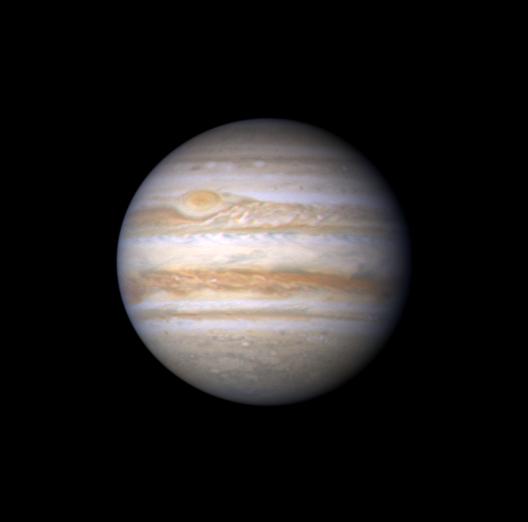| The Cassini-Huygens mission |

These three images of Jupiter, taken through the narrow angle camera from a distance of 77.6 million km on October 8, 2000 and reduced by a factor of 2 in size from a full-resolution image, reveal more than is apparent to the naked eye through a telescope. The image on the left was taken at 16:58 UTC/SCET through the blue filter (centered at 445 nanometers in wavelength), within the part of the electromagnetic spectrum detectable by the human eye. The appearance of Jupiter in this image is consequently, very familiar: the Great Red Spot (a little below and to the right of center) and the planet's well-known banded cloud lanes are obvious. The brighter bands of clouds are called zones and are probably composed of ammonia ice particles. The darker bands are called belts and are made dark by particles intermixed with the ammonia ice. The composition of the latter is unknown. Jupiter's appearance changes dramatically in the images to the right, which were taken at 16:55 UTC/SCET in the ultraviolet at 255 nanometers (middle) and in the near infrared at 889 nanometers (extreme right). These images are near negatives of each other and illustrate the way in which observations in different wavelength regions can reveal different physical regimes on the planet.
All gases scatter sunlight efficiently at short wavelengths; this is why the sky appears blue on Earth. The effect is even more pronounced in the ultraviolet. The gases in Jupiter's atmosphere, above the clouds, are no different: they scatter strongly in the ultraviolet, making the deep banded cloud layers invisible in the middle image. Only the very high altitude haze appears dark against the bright background. The contrast is reversed in the near infrared, where methane gas, abundant on Jupiter but not on Earth, is strongly absorbing and therefore appears dark. Again the deep clouds are invisible, but now the high altitude haze appears relatively bright against the dark background. High altitude haze is seen over the poles and the equator. The Great Red Spot, prominent in all images, is obviously a feature whose influence extends high in the atmosphere.
As the Cassini cameras continue to return images of Jupiter throughout the encounter, it will be possible to construct a three-dimensional picture of how clouds form and evolve by watching the changing appearance of Jupiter in different spectral regions.
Credit: NASA/JPL/University of Arizona
Released: October 23, 2000
South up

This true color image of Jupiter is composed of three images taken in the blue, green and red regions of the spectrum. All images were taken from a distance of 77.6 million km on October 8, 2000, around 16:57 UTC/SCET (spacecraft event time). The resolution is 466 km. Different chemical compositions of the cloud particles lead to different colors; the cloud patterns reflect different physical conditions -- updrafts and downdrafts -- in which the clouds form. The bluish areas are believed to be regions devoid of clouds and covered by high haze. The Great Red Spot (below and to the right of center) is a giant atmospheric storm about 2 Earths across and over 300 years old, with peripheral winds of 300 miles per hour. This image shows that it is trailed to the west by a turbulent region, caused by an atmospheric flow around the northern perimeter of the Spot. The small very white features in this region are lightning storms, which were seen by the Galileo spacecraft when it photographed the night side of Jupiter.
Cassini will track these lightning storms and measure their lifetimes and motions when it passes Jupiter in late December and looks back at the dark side of the planet.
Credit: NASA/JPL/University of Arizona
Released: October 23, 2000
[NASA/JPL/Space Science Institute]
 ALPO-Japan Latest
ALPO-Japan Latest

 Jupiter2000 Apparition
Jupiter2000 Apparition